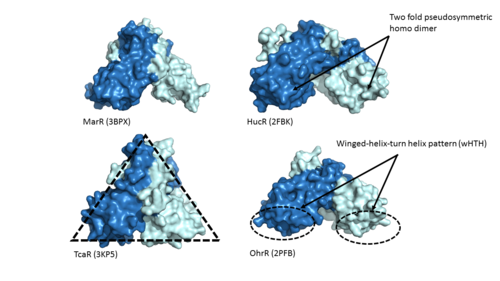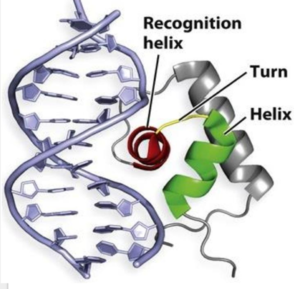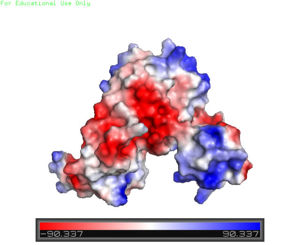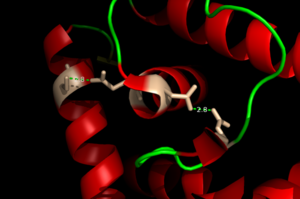Sandbox Reserved 1063
From Proteopedia
(Difference between revisions)
| Line 16: | Line 16: | ||
[[Image:Screen Shot 2017-04-18 at 11.56.32 PM.png|300 px|right|thumb|'''Figure 2'''. A generic protein representing the [https://images.google.com/imgres?imgurl=https%3A%2F%2Fclassconnection.s3.amazonaws.com%2F838%2Fflashcards%2F2220838%2Fjpg%2Fasdf-144940F88BA53A918F3.jpg&imgrefurl=https%3A%2F%2Fwww.studyblue.com%2Fnotes%2Fnote%2Fn%2Flecture-13%2Fdeck%2F10226974&docid=qBvv1vgKeLTGcM&tbnid=3nuaRjPWKUBfqM%3A&vet=1&w=741&h=756&hl=en&source=sh%2Fx%2Fim wHTH] motif binding the major and minor groove of DNA similar to AdcR.]] | [[Image:Screen Shot 2017-04-18 at 11.56.32 PM.png|300 px|right|thumb|'''Figure 2'''. A generic protein representing the [https://images.google.com/imgres?imgurl=https%3A%2F%2Fclassconnection.s3.amazonaws.com%2F838%2Fflashcards%2F2220838%2Fjpg%2Fasdf-144940F88BA53A918F3.jpg&imgrefurl=https%3A%2F%2Fwww.studyblue.com%2Fnotes%2Fnote%2Fn%2Flecture-13%2Fdeck%2F10226974&docid=qBvv1vgKeLTGcM&tbnid=3nuaRjPWKUBfqM%3A&vet=1&w=741&h=756&hl=en&source=sh%2Fx%2Fim wHTH] motif binding the major and minor groove of DNA similar to AdcR.]] | ||
The AdcR MarR transcriptional regulator's structure resembles that of other proteins in the MarR family; however, the most notable differences are found in the winged helix-turn-helix (wHTH) motif (Figure 2) that assists in binding DNA <ref name="guerra" />. The <scene name='69/694230/Whth_4/7'>winged helix turn helix</scene> motif is made up of the <font color='blue'>α3</font> and <font color='blue'>α4 helices</font> along with <scene name='69/694230/Anti-parallel_beta_sheet/2'>anti-parallel β sheets</scene> on each side. There is one wHTH motif per monomer. The recognition helix, or the α4 helix, binds the major groove of DNA through [https://en.wikipedia.org/wiki/Hydrogen_bond hydrogen bonding] and [https://en.wikipedia.org/wiki/Van_der_Waals_force Van der Waals interactions] between exposed bases <ref name="guerra" />. The wings of the helix bind the minor groove of DNA while the other helices stabilize the DNA and Protein upon binding. The two anti parallel β sheets contain several <scene name='69/694230/Positive_residues_on_wing_3/4'>Arginine, Asparagine, and Lysine residues</scene> that stabilize this interaction between DNA. The charge map (Figure 3) highlights the dark blue tips of the wHTH motif consisting of lysine and arginine residues, which stabilize the negatively charged backbone of DNA. The residues are only shown on the random loop of one monomer because the random loop on the other protein monomer <scene name='69/694230/Uncrystallized_loop/1'>was not crystallized</scene>. | The AdcR MarR transcriptional regulator's structure resembles that of other proteins in the MarR family; however, the most notable differences are found in the winged helix-turn-helix (wHTH) motif (Figure 2) that assists in binding DNA <ref name="guerra" />. The <scene name='69/694230/Whth_4/7'>winged helix turn helix</scene> motif is made up of the <font color='blue'>α3</font> and <font color='blue'>α4 helices</font> along with <scene name='69/694230/Anti-parallel_beta_sheet/2'>anti-parallel β sheets</scene> on each side. There is one wHTH motif per monomer. The recognition helix, or the α4 helix, binds the major groove of DNA through [https://en.wikipedia.org/wiki/Hydrogen_bond hydrogen bonding] and [https://en.wikipedia.org/wiki/Van_der_Waals_force Van der Waals interactions] between exposed bases <ref name="guerra" />. The wings of the helix bind the minor groove of DNA while the other helices stabilize the DNA and Protein upon binding. The two anti parallel β sheets contain several <scene name='69/694230/Positive_residues_on_wing_3/4'>Arginine, Asparagine, and Lysine residues</scene> that stabilize this interaction between DNA. The charge map (Figure 3) highlights the dark blue tips of the wHTH motif consisting of lysine and arginine residues, which stabilize the negatively charged backbone of DNA. The residues are only shown on the random loop of one monomer because the random loop on the other protein monomer <scene name='69/694230/Uncrystallized_loop/1'>was not crystallized</scene>. | ||
| + | [[Image:Charge_map.jpg |300 px|right|thumb|'''Figure 3'''. A charge map of AdcR shows the general triangular shape and the <font color='blue'>positively</font> charged area on the tips of the wHTH motif]] | ||
== '''Zn(II) Binding''' == | == '''Zn(II) Binding''' == | ||
Zinc-Dependent Transcriptional Regulator AdcR has <scene name='69/694230/2_binding_sites/4'>two binding sites for zinc</scene> on each of its two protomers and can bind a total of four Zn(II) ions. The <scene name='69/694230/Alpha1-alpha2_loop/2'>α1-α2 loop</scene> combined with the <scene name='69/694230/Alpha_five/1'>α5 helix</scene> and <scene name='69/694230/Alpha_2/1'>α2 helix</scene> make up the <scene name='69/694230/Two_binding_sites/2'>metal binding sites</scene>. Each protomer has one high affinity site (Binding site 1; KZn<sub>1</sub> = 10<sup>12</sup> M; pH 8) and one low affinity binding site (Binding Site 2; KZn<sub>2</sub> = 10<sup>7</sup> M; pH 8) <ref name="Reyes">PMID:20804771</ref>. The two different Zn(II) binding sites are connected via <scene name='69/694230/Hydrogen_bonding/5'>hydrogen bonding</scene> of H108 and E41. | Zinc-Dependent Transcriptional Regulator AdcR has <scene name='69/694230/2_binding_sites/4'>two binding sites for zinc</scene> on each of its two protomers and can bind a total of four Zn(II) ions. The <scene name='69/694230/Alpha1-alpha2_loop/2'>α1-α2 loop</scene> combined with the <scene name='69/694230/Alpha_five/1'>α5 helix</scene> and <scene name='69/694230/Alpha_2/1'>α2 helix</scene> make up the <scene name='69/694230/Two_binding_sites/2'>metal binding sites</scene>. Each protomer has one high affinity site (Binding site 1; KZn<sub>1</sub> = 10<sup>12</sup> M; pH 8) and one low affinity binding site (Binding Site 2; KZn<sub>2</sub> = 10<sup>7</sup> M; pH 8) <ref name="Reyes">PMID:20804771</ref>. The two different Zn(II) binding sites are connected via <scene name='69/694230/Hydrogen_bonding/5'>hydrogen bonding</scene> of H108 and E41. | ||
| Line 25: | Line 26: | ||
=== Hydrogen Bond Network === | === Hydrogen Bond Network === | ||
| - | [[Image:Charge_map.jpg |300 px|right|thumb|'''Figure 3'''. A charge map of AdcR shows the general triangular shape and the <font color='blue'>positively</font> charged area on the tips of the wHTH motif]] | ||
The binding of zinc metals creates a hydrogen bond network within the protein that connects the metal binding sites and the [https://en.wikipedia.org/wiki/DNA-binding_domain DNA binding domain]. The <scene name='69/694230/Hydrogen_bonding_1/5'>hydrogen bond network</scene> (<scene name='69/694230/Hydrogen_bonding_2/5'>with measurements</scene>) is represented by each atom type in the 3D model. The hydrogen bond network is characteristic of the MarR family as a whole. More importantly, the hydrogen bonding network connects the metal binding pockets to the α4 helix also known as the recognition helix. <scene name='69/694230/Recognition_helix/3'>Several residues</scene> in the recognition helix recognize a sequence of DNA that is unknown at the moment; however, scientists are aware that the hydrogen bond network acts as an allosteric activator for the protein to bind DNA. The hydrogen bond network connects the α2 and α4 helix via hydrogen bonding between specific residues. After zinc is bound, a glutamate (E24) residue from a random coil accepts a hydrogen bond from the carboxamide end of an asparagine (N38) residue from the α2 helix. Then, a glutamine (Q40) residue from α2 helix accepts a hydrogen bond from a serine (S74) residue from the α4 helix <ref name="guerra" />. The binding of zinc allows for these conformational changes that induces the binding of DNA in order to activate genes. | The binding of zinc metals creates a hydrogen bond network within the protein that connects the metal binding sites and the [https://en.wikipedia.org/wiki/DNA-binding_domain DNA binding domain]. The <scene name='69/694230/Hydrogen_bonding_1/5'>hydrogen bond network</scene> (<scene name='69/694230/Hydrogen_bonding_2/5'>with measurements</scene>) is represented by each atom type in the 3D model. The hydrogen bond network is characteristic of the MarR family as a whole. More importantly, the hydrogen bonding network connects the metal binding pockets to the α4 helix also known as the recognition helix. <scene name='69/694230/Recognition_helix/3'>Several residues</scene> in the recognition helix recognize a sequence of DNA that is unknown at the moment; however, scientists are aware that the hydrogen bond network acts as an allosteric activator for the protein to bind DNA. The hydrogen bond network connects the α2 and α4 helix via hydrogen bonding between specific residues. After zinc is bound, a glutamate (E24) residue from a random coil accepts a hydrogen bond from the carboxamide end of an asparagine (N38) residue from the α2 helix. Then, a glutamine (Q40) residue from α2 helix accepts a hydrogen bond from a serine (S74) residue from the α4 helix <ref name="guerra" />. The binding of zinc allows for these conformational changes that induces the binding of DNA in order to activate genes. | ||
[[Image:H Bonding of DNA.png|300 px|left|thumb|'''Figure 4'''. The Hydrogen Bonding Network is shown with dotted green lines approximately 2.8 angstroms between residues.]] | [[Image:H Bonding of DNA.png|300 px|left|thumb|'''Figure 4'''. The Hydrogen Bonding Network is shown with dotted green lines approximately 2.8 angstroms between residues.]] | ||
Revision as of 19:17, 4 December 2017
Adhesin Competence Regulator
| |||||||||||
References
- ↑ 1.0 1.1 Sanson M, Makthal N, Flores AR, Olsen RJ, Musser JM, Kumaraswami M. Adhesin competence repressor (AdcR) from Streptococcus pyogenes controls adaptive responses to zinc limitation and contributes to virulence. Nucleic Acids Res. 2015 Jan;43(1):418-32. doi: 10.1093/nar/gku1304. Epub 2014 Dec, 15. PMID:25510500 doi:http://dx.doi.org/10.1093/nar/gku1304
- ↑ Grove A. MarR family transcription factors. Curr Biol. 2013 Feb 18;23(4):R142-3. doi: 10.1016/j.cub.2013.01.013. PMID:23428319 doi:http://dx.doi.org/10.1016/j.cub.2013.01.013
- ↑ Ma Z, Jacobsen FE, Giedroc DP. Coordination chemistry of bacterial metal transport and sensing. Chem Rev. 2009 Oct;109(10):4644-81. doi: 10.1021/cr900077w. PMID:19788177 doi:http://dx.doi.org/10.1021/cr900077w
- ↑ 4.0 4.1 4.2 4.3 4.4 4.5 Guerra AJ, Dann CE, Giedroc DP. Crystal Structure of the Zinc-Dependent MarR Family Transcriptional Regulator AdcR in the Zn(II)-Bound State. J Am Chem Soc. 2011 Nov 21. PMID:22085181 doi:10.1021/ja2080532
- ↑ 5.0 5.1 Reyes-Caballero H, Guerra AJ, Jacobsen FE, Kazmierczak KM, Cowart D, Koppolu UM, Scott RA, Winkler ME, Giedroc DP. The metalloregulatory zinc site in Streptococcus pneumoniae AdcR, a zinc-activated MarR family repressor. J Mol Biol. 2010 Oct 22;403(2):197-216. doi: 10.1016/j.jmb.2010.08.030. Epub 2010, Sep 8. PMID:20804771 doi:http://dx.doi.org/10.1016/j.jmb.2010.08.030




